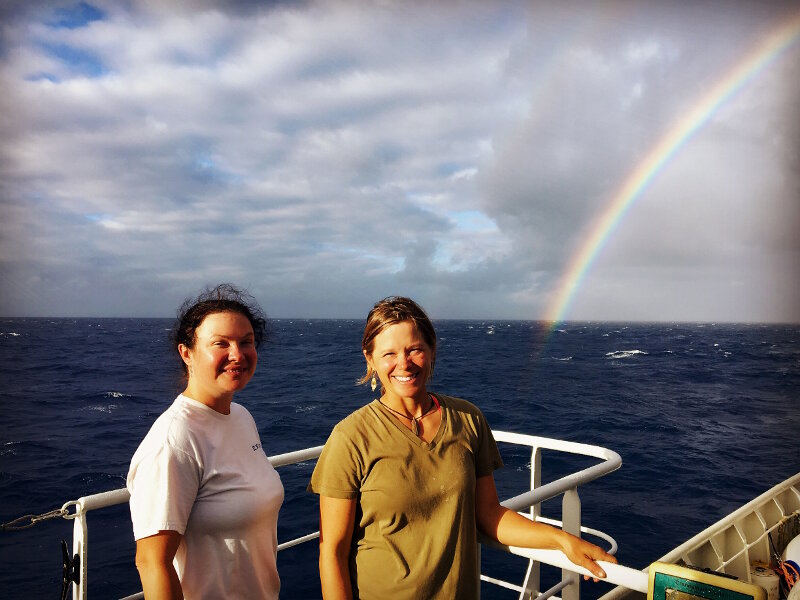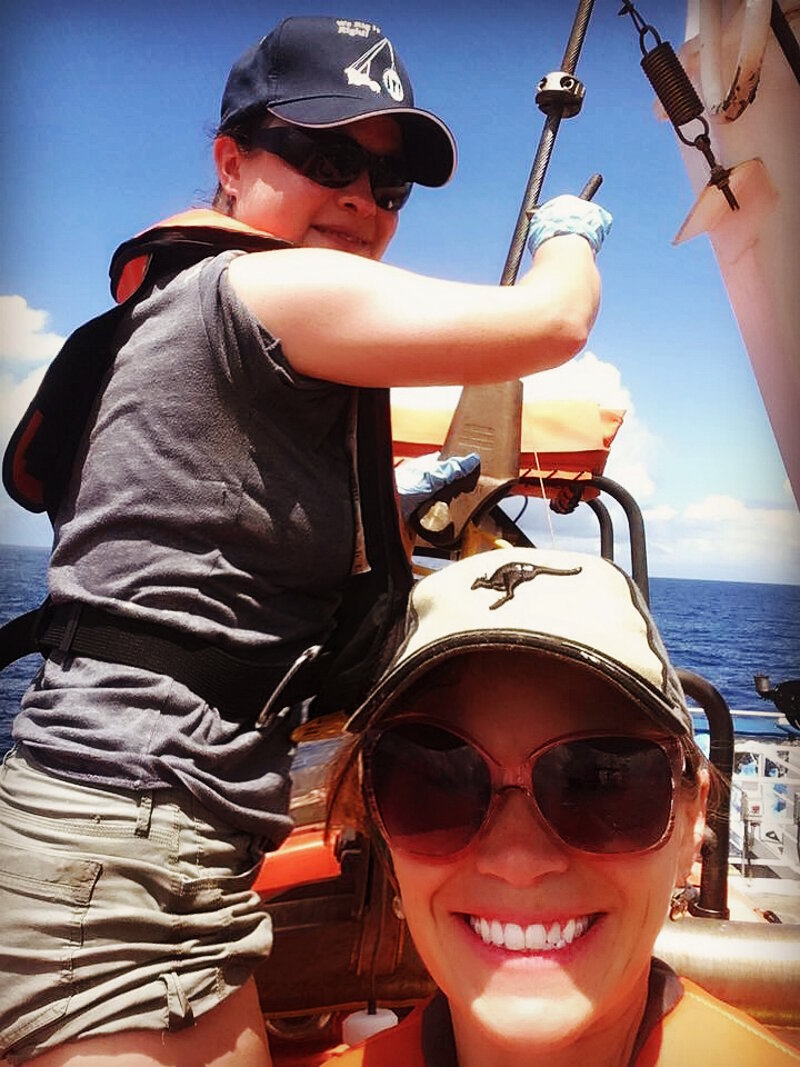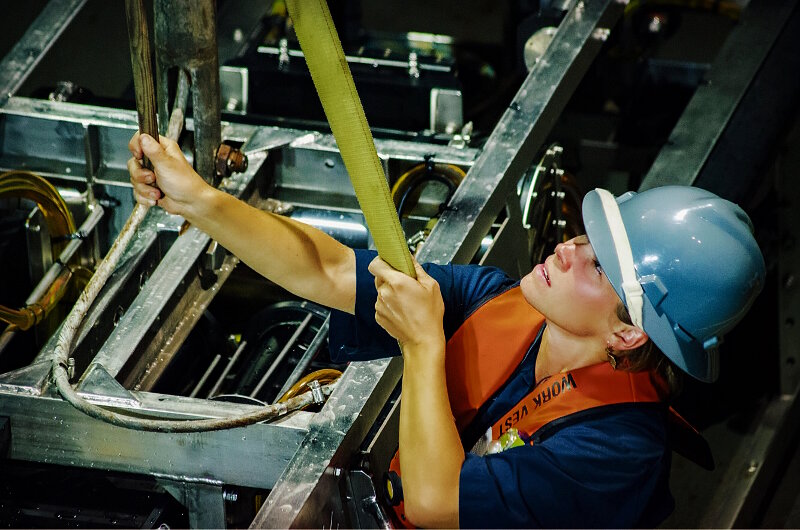
Amy Bowman - NOAA Office of Ocean Exploration and Research
May 15, 2017

The women of the deck department on NOAA Ship Okeanos Explorer. A squall has passed and left a rainbow behind. Image courtesy of the NOAA Office of Ocean Exploration and Research, Mountains in the Deep: Exploring the Central Pacific Basin. Download larger version (jpg, 3.9 MB).
What does it take to work on NOAA Ship Okeanos Explorer? It takes a great attitude, a strong work ethic, intelligence, and grit. Lindsey Houska and Nicole Turpin of the deck department embody all of these traits – and more!
NOAA has civilian mariners aboard its research vessels who work in support of NOAA's mission. This includes members of the deck department, wage mariners who are an integral part of understanding the condition of both the ocean and atmosphere. They add a seaman's knowledge to NOAA's scientific research by directly participating in the operation and handling of scientific gear in the tumultuous ocean environment. This highly skilled and technical workforce provides NOAA with the ability to achieve success while conducting missions, like the ocean exploration mission aboard NOAA Ship Okeanos Explorer.

Nicole Turpin (left) and Lindsey Houska (right) always come to work with a smile. Image courtesy of the NOAA Office of Ocean Exploration and Research, Mountains in the Deep: Exploring the Central Pacific Basin. Download larger version (jpg, 659 KB).
This is no small task. Deckhands need to be capable of lifting and moving heavy, large, awkward, and expensive equipment in an environment that is in a constant state of flux. Not only do they handle the equipment, they also maintain the ship and its equipment, operate the ship's machinery (i.e., winches and cranes), manage the lines, and deploy the small boats. The deck crew also deploys and recovers oceanographic instruments – like remotely operated vehicles (ROVs) Seirios and Deep Discoverer.
This is not a career for the faint of heart, or for the weak of body or mind. On top of having very good judgement, deckhands must be intelligent, strong, and in good physical health. They must be able to perform emergency duties at a moment's notice without danger to themselves or the ship. They must be able to work in all types of weather, day and night, while on a moving platform. Good working relationships with other members of the crew are an important part of the daily routine aboard the boat – a positive attitude goes a long way on a ship.
When I met with crewmembers, Lindsey and Nicole, I found their can-do attitudes quite impressive. With every interaction I had with them, my respect for their abilities grew. They are confident, intelligent women who work hard and have a passion for what they do. Each arrived at this career on her own path.
Nicole had known from the time she was a child that she wanted a life at sea. She grew up in California staring out at the sea, mesmerized by its beauty, wanting to be there. Her love of the ocean made her uniquely qualified for this work. She had already been sailing for many years when she met people from NOAA who suggested the agency as a career path almost three years ago.
Lindsey did not grow up on the ocean – she is from South Dakota. She had felt unfulfilled while working as a statistician and decided to see the world on a grand adventure, spending time in exotic places like Thailand. While visiting Australia, she met a fisherman who suggested she come work for him. That was her first seafaring job and she never looked back. She has also been with NOAA for about three years.

Nicole Turpin recovering the ROVs at night on NOAA Ship Okeanos Explorer. Image courtesy of Caitlin Bailey, GFOE. Download larger version (jpg, 3.4 MB).

Lindsey Houska deftly secures camera sled Seirios on the deck of NOAA Ship Okeanos Explorer. Image courtesy of Caitlin Bailey, GFOE. Download larger version (jpg, 1.0 MB).
Both women are happy working on NOAA Ship Okeanos Explorer. It is their favorite NOAA ship to date, although they both have had many positive experiences on other ships. Here, they have an exceptional team and enjoy the camaraderie. Nicole performed her first-ever ROV recovery on this expedition. While she felt a bit nervous at first, she was able to get the feel for how to handle this challenging task very quickly. She likes the fact that her team lead trusts her abilities to manage a heavy, awkward, expensive piece of equipment like the 9,000-pound ROV.
These hard-working women are also ambitious, each already has her Able Seaman certification. In addition, Lindsey already has her 100-ton merchant mariner license. Nicole is testing for her unlimited third mate license soon – she has always wanted to work on big ships.
Both women had some advice for those looking to work at sea. "If you want to advance, get your degree early," said Nicole. "Engineering knowledge can really help you succeed in this line of work." She went on to mention that both mechanical and electrical engineering are worthwhile fields of study for this industry.
"Give this lifestyle a try before you commit," suggested Lindsey. "It is hard to have a traditional lifestyle at sea, so you need to decide if you have what it takes before you invest." She mentioned that there are many opportunities to try this type of work short-term by getting on a yacht or fishing boat for a season. The Internet is also full of good websites that link potential crew members to positions. She went on to say, "I was able to pay off debt in a very short time – one and a half years – because my expenses were low and I had no rent. It's a great way to get ahead."
They love this job. Both are excited by the scientific mission and feel that they get a chance to learn something new every day. "We see discovery happen in real time," said Nicole. "I have so much fun it doesn't even feel like work."
Both agreed that there was no real hard part of the job and thought it would only be hard if they made it hard. However, watching the work they perform every day during this expedition, anyone can see that each woman is a very hard worker. They usually work 10 to 12 hours per day and sometimes get pretty dirty. At sea, there is no such thing as a day off. That said, I can also see how happy they are because they always come to work with a smile.